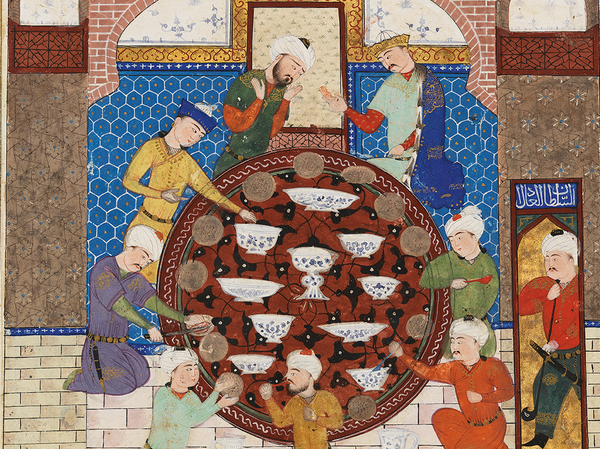Among the hundreds of objects at an upcoming exhibition at the Detroit Institute of Arts Museum, there’s one that stands out: a lovely turquoise-tinted pitcher, shaped like a rooster.
Curator Katherine E. Kasdorf calls it “fabulous.” The ewer, she explains, dates back to 13th-century Iran. “The handle is shaped like the tail, and you imagine somebody pouring, and then the liquid comes out of the beak,” she says. “It’s just a fun object. It would have been a fun conversation piece when it was being used, too.”
The Art of Dining: Food Culture in the Islamic World, which opens on September 22, spans centuries and continents of culinary history. The exhibition’s objects originate everywhere from Spain to South Asia. The very oldest, Kasdorf says, date back to the pre-Islamic Sasanian Empire, which was located in Iran and part of present-day Iraq from the third through seventh centuries.

Many of the objects in the exhibition, such as the rooster ewer, combine beautiful design with their utility. But alongside spoons and serving trays are paintings and cookbooks. “Some of the earliest cookbooks from the medieval period were actually written in Arabic,” Kasdorf says. “There’s a very long tradition of recipe books in the Islamic world.”
The Art of Dining originally began as a show at the Los Angeles County Museum of Art. That exhibition, which closed in August, featured 12 objects from the collection at Detroit Institute of Arts (DIA). As for why DIA chose to mount their own exhibition, Kasdorf points to Detroit’s robust Arab-American community. The city is home to the largest population of Arabic speakers in the United States, “in addition to being home to many other communities that might find some personal connection to the regions represented in the show,” Kasdorf adds.

Many of the objects on display are imbued with cultural meaning that might not be apparent at first glance. In the case of the rooster ewer, Kasdorf says it’s theorized that it was used for wine. “There’s this tradition in Iran, going back to antiquity, where there is a very strong association between bird-headed vessels and wine,” she says. While many Islamic teachings forbid drinking alcohol, Kasdorf notes that wine-drinking “was a very strong part of elite banqueting during the Sasanian period. And these traditions of Sasanian elite banqueting were carried over by early Islamic courts as well.”
The exhibition goes beyond simply featuring serving dishes and cookbooks. The “Dressing for Dinner” section displays historical outfits and textiles such as napkins from the Ottoman Empire, and the “Music and Entertainment” section showcases instruments accompanied by QR codes for visitors to listen to them being played. There are also QR codes for historical recipes interpreted for the original LACMA exhibition by chef Najmieh Batmanglij, such as a 16th-century Iranian recipe for rice and lamb with chickpeas and barberries and a 19th-century Turkish recipe for a minced chicken pie.

The most modern work in the show was commissioned by LACMA from the artist Sadik Kwaish Alfraji. A Thread of Light Between My Mother’s Fingers and Heaven is a multimedia installation featuring animation. The piece is also food-focused, centering on Alfraji’s mother, her homemade bread, and family meals in Bagdad.
Kasdorf notes that while the original LACMA show and the upcoming exhibition at DIA are closely related, “we’ve really tailored it and personalized it for our audiences here.” For example, they held a town hall for community members to weigh in on the name of the show. “It was just really important to us that we listened to our community members and that we present the show in a way that is welcoming and resonant to them.
Iraqi Traditional Bread
Recipe by Umm Sadik
Ingredients
- 8 cups wheat flour (brown or white or a mixture of both)
- 1 tablespoon yeast
- Warm water, as needed while at work
- 1/2 tablespoon salt
Instructions
- Mix the yeast, salt, and a little warm water in a deep bowl, then add the flour and a small amount of warm water. Start kneading with your hands. Add small amounts of water whenever needed, and continue kneading until the dough becomes soft, cohesive, and sticks to your hands.
- Shape the dough into a single mass, make holes in it with your finger, then cover it with warm water and let it sit for about 15 minutes.
- Drain the excess water from the bowl and start kneading the dough again with your hands to increase its consistency and softness. Cover the bowl with a piece of cloth or nylon and leave it for 1 1/2 hours or more. If the weather is cold, put a blanket over the dough so that it ferments faster.
- After the dough rises, cut it into small balls, about the size of a fist, and place them on a tray sprinkled with flour. Leave them, uncovered, for 30 minutes or more, as they will double in size.
- As the dough balls sit, prepare the tandoor oven for baking (the temperature should be very hot).
- Flip each ball of dough with your hands until it becomes round and thin. Then push each dough ball to the oven wall with enough force that it sticks. Bake until brown and toasty.
Gastro Obscura covers the world’s most wondrous food and drink.
Sign up for our email, delivered twice a week.

